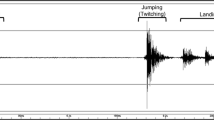Abstract
Individual variation is a ubiquitous and important factor that affects ecological dynamics. This study examined individual variation in the nest-use pattern of the jumping spider Phidippus audax. Although the jumping spider is a diurnal species, field observations in this study revealed that the majority of individuals remained in their nests during the day. An accompanying examination of the hunger level of the spiders revealed that spiders that remained in nests were more starved than those observed outside nests. If spiders actively forage when they are starved, as has been suggested by previous studies, one would expect to see the opposite trend (i.e., spiders that remained in nests are more satiated). Thus, the pattern observed in the field contradicts the known behavioral pattern of the spiders. An individual-based model was used to investigate the behavioral mechanism of the spider and the discrepancy found in the observations. A basic assumption of the model is that spiders possess distinct inactive and active phases (biphasic activity pattern), and transitions between the two phases are regulated by the hunger level of the spider. Data from a laboratory experiment were used to examine the assumptions of the model partially. The model was able to capture patterns observed in the data, suggesting that the pattern of transitions in biphasic activity is an important trait of the foraging behavior of the jumping spider.



Similar content being viewed by others
References
Abrams PA (1992) Predators that benefit prey and prey that harm predators: unusual effects of interacting foraging adaptations. Am Nat 140:573–600
Anderson JF (1996) Metabolic rates of resting salticid and thomicid spiders. J Arachnol 24:129–134
Anholt BR, Werner E, Skelly DK (2000) Effect of food and predators on the activity of four larval ranid frogs. Ecology 81:3509–3521
Bilde T, Toft S (1998) Quantifying food limitation of arthropod predators in the field. Oecologia 115:54–58
Bolker B, Holyoak M, Křivan V, Rowe L, Schmitz O (2003) Connecting theoretical and empirical studies of trait-mediated interactions. Ecology 84:1101–1114
Carducci J, Jakob E (2000) The effect of rearing environments on the behavior of a jumping spider. Anim Behav 59:39–46
Caro T (2005) Antipredator defences in birds and mammals. University of Chicago Press, Chicago
Cooper WE Jr, Anderson RA (2006) Adjusting prey handling times and methods affects profitability in the broad-headed skink (Eumeces laticeps). Herpetologica 62:356–365
Edwards GB (2004) Revision of the jumping spiders of the genus Phidippus (Araneae: Salticidae). Occasional Papers of the Florida State Collection of Arthropods, vol. 11. Gainesville, FL
Gardner BT (1964) Hunger and sequential responses in the hunting behavior of salticid spiders. J Comp Physiol Psychol 58:167–173
Givens RP (1978) Dimorphic foraging strategies of salticid spider Phidippus audax. Ecology 59:309–321
Hilborn R, Mangel M (1997) The ecological detective. Princeton University Press
Hill DE (1979) Orientation by jumping spiders of the genus Phidippus (Aranae: Salticidae) during the pursuit of prey. Behav Ecol Sociobiol 5:301–322
Hoefler CD, Jakob EM (2006) Jumping spiders in space: movement patterns, nest site fidelity and the use of beacons. Anim Behav 71:109–116
Holt RD, Polis GA (1997) A theoretical framework for intraguild predation. Am Nat 149:745–764
Isagi Y, Sugimura K, Sumida A, Ito H (1997) How does masting happen and synchronize? J Theor Biol 187:231–239
Iwasa Y, Satake A (2004) Mechanisms inducing spatially extended synchrony in mast seeding: The role of pollen coupling and environmental fluctuation. Ecol Res 19:13–20
Jackson RR, Pollard SD (1996) Predatory behavior of jumping spiders. Annu Rev Entomol 41:287–308
Jackson RR, Pollard SD, Salm K (2008) Observations of Portia africana, an araneophagic jumping spider, living together and sharing prey. NZ J Zool 35:237–242
Krone O, Berger A, Schulte R (2009) Recording movement and activity pattern of a White-tailed Sea Eagle (Haliaeetus albicilla) by a GPS datalogger. J Ornithol 150:273–280
Land MF (1972) Mechanism of orientation and pattern recognition by jumping spiders. In: Wehner R (ed) Information processing in the visual systems of arthropods. Springer Verlag, Berlin
Li DQ, Jackson RR, Lim MLM (2003) Influence of background and prey orientation on an ambushing predator’s decisions. Behaviour 140:739–764
McCormic MI, Larson JK (2008) Effect of hunger on the response to, and the production of, chemical alarm cues in a coral reef fish. Anim Behav 75:1973–1980
Mooney KA, Haloin JR (2005) Nest site fidelity of Paraphidippus aurantia (Salticidae). J Arachnol 34:241–243
Okuyama T (2007) Prey of two species of jumping spiders in the field. Appl Entomol Zool 42:663–668
Okuyama T (2008) Individual behavioral variation in predator-prey models. Ecol Res 23:665–671
Okuyama T (2009) Local interactions between predators and prey call into question commonly used functional responses. Ecol Model 220:1182–1188
Osborne JL, Clark SJ, Morris RJ, Williams IH, Riley JR, Reynolds DR, Edwards AS (1999) A landscape-scale study of bumble bee foraging range and constancy using harmonic radar. J Appl Ecol 36:519–533
Persons MH, Rypstra AL (2001) Wolf spiders show graded antipredator behavior in the presense of chemical cues from different sized predators. J Chem Ecol 27:2493–2504
Rienks JH (2000) Extended nest residence and cannibalism in a jumping spider (Araneae, Salticidae). J Arachnol 28:123–127
Ruxton GD (2006) The unequal variance t-test is an underused alternative to Student’s t-test and the Mann-Whitney U test. Behav Ecol 17:688–690
Walker SE, Rypstra AL (2003) Hungry spiders aren’t afraid of big bad wolf spider. J Arachnol 66:425–427
Acknowledgements
I thank Ben Bolker, Jane Brockmann, Jim Hobert, Bob Holt, Craig Osenberg, Steve Phelps, Charlotte Skov, and Bob Ruyle, as well as two anonymous reviewers for their support and insightful comments. This study was partially funded by National Science Council of Taiwan (97-2321-B-002-036-MY2).
Author information
Authors and Affiliations
Corresponding author
Additional information
Communicated by Tatiana Czeschlik
Rights and permissions
About this article
Cite this article
Okuyama, T. Biphasic activity of a jumping spider. Naturwissenschaften 98, 15–22 (2011). https://doi.org/10.1007/s00114-010-0734-3
Received:
Revised:
Accepted:
Published:
Issue Date:
DOI: https://doi.org/10.1007/s00114-010-0734-3




